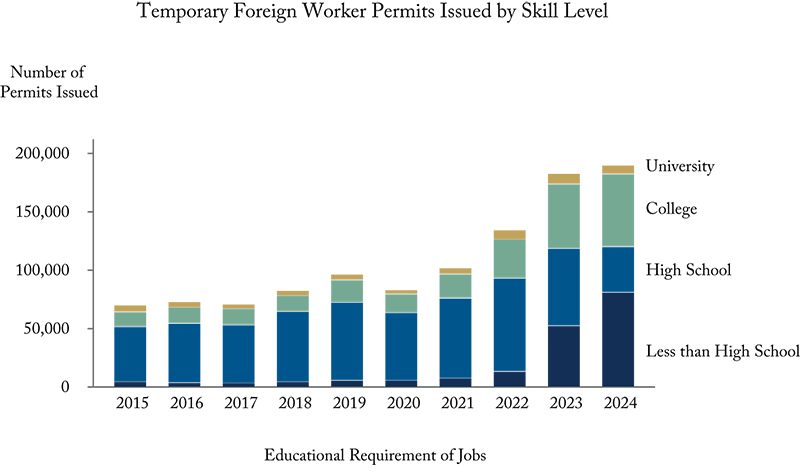Home / Publications / Intelligence Memos / A Realistic Strategy to Wean Canadian Businesses Off Low-Skill Foreign Labour
- Intelligence Memos
- |
A Realistic Strategy to Wean Canadian Businesses Off Low-Skill Foreign Labour
Summary:
| Citation | Mikal Skuterud. 2025. "A Realistic Strategy to Wean Canadian Businesses Off Low-Skill Foreign Labour." Intelligence Memos. Toronto: C.D. Howe Institute. |
| Page Title: | A Realistic Strategy to Wean Canadian Businesses Off Low-Skill Foreign Labour – C.D. Howe Institute |
| Article Title: | A Realistic Strategy to Wean Canadian Businesses Off Low-Skill Foreign Labour |
| URL: | https://cdhowe.org/publication/a-realistic-strategy-to-wean-canadian-businesses-off-low-skill-foreign-labour/ |
| Published Date: | September 9, 2025 |
| Accessed Date: | October 23, 2025 |
Outline
Outline
Related Topics
Files
From: Mikal Skuterud
To: Labour Market Watchers
Date: September 9, 2025
Re: A Realistic Strategy to Wean Canadian Businesses Off Low-Skill Foreign Labour
Uprooting one’s life to settle in a new country is always daunting, but it’s particularly unnerving when immigration rules are in constant flux. Attracting foreign talent requires a system that is stable, transparent, and predictable.
The Conservative Party of Canada’s recent demand that the Temporary Foreign Worker (TFW) Program be shuttered risks repeating the pattern of abrupt, whipsaw policy change that creates uncertainty, and risks deterring skilled migrants. It could even potentially politicize immigration in such a way that risks undermining public confidence in the immigration system.
More targeted reforms of the TFW program would see less emphasis on filling lower-wage jobs, and include a push for more strategic changes that encourage businesses to invest in technology and upskill their workforces.
The current backlash against the TFW program is not new. When unemployment rates increased in 2008 and 2014, the program became a similar flashpoint, resulting in new regulations that were then undone in 2022. It’s time to move beyond this cycle of knee-jerk political reaction and chart a stable course for reform.
What is being overlooked in current calls to shut down the TFW program is its critical role in enabling the recruitment of genuine foreign talent, especially in high-tech and universities. As US immigration policy cools, Canada should be leaning in on the Global Talent Stream of the TFW Program, not shutting it down.
As the chart below shows, the share of TFWs employed in jobs requiring postsecondary education increased from 21 to 37 percent between 2018 and 2024, though “cooks” and “food service supervisors” – occupations that may not consistently require postsecondary education – made up 32 percent of 2021-2025 entries at the college level.
The TFW program is a critical piece of an optimal two-step immigration system, in which Canadian businesses can quickly recruit skilled labour, put it to work, and on a path to permanent residency through the Express Entry System.
Nonetheless, as the data also show, most of the growth in TFW entries since 2015 has been in jobs that require less than a high school diploma. Most of this growth is harvesting labourers on farms, but entries of janitors, cleaners, and general labourers in manufacturing, construction, and seafood processing have also been substantial.
What matters for the size of the job displacement and wage suppression effects of TFWs is their share of the low-skill labour force. Yet the stock population of TFWs is not what the 2025-2027 government’s Immigration Levels Plan targets, since those figures exclude new permits issued to people already in Canada on work or study permits. Moreover, there is no way to even know what the current population of low-skill TFWs in Canada is given publicly available data.
Government reporting on the population of TFW provides only an annual snapshot as of December 31 – when the seasonal agricultural workforce is likely at its lowest – and does not break down the stock population by skill level or occupation.
The policy goal should not be to eliminate the TFW program outright but to reform it.
This requires three steps: First, ensure employer access to high-skill streams, such as the Global Talent Stream; second, introduce quarterly public reporting on the stock and occupational distribution of TFWs to ensure transparency and accountability; and third, phase out low-skill streams, including in agriculture and caregiving, over three to five years.
This horizon gives viable businesses time to make productivity-enhancing training and technological investments, reducing reliance on low-wage foreign labour while supporting wage growth and productivity gains in the domestic workforce.
A key policy instrument in this transition that has been overlooked in the current debate is the $1,000 fee per position that employers pay for an Labour Market Impact Assessment (LMIA). This fee has not changed since June 2014, when it was introduced.
The current flat fee should be replaced with a new LMIA fee structure for TEER 4/5 occupations with higher fees where local unemployment rates are higher and escalating fees where employers are using the program repeatedly in consecutive years to employ workers in the same occupations.
Using statistical estimates of the responsiveness of TFW demand to marginal increases in fees, fees can be adjusted over time, as well as between regions and occupations, to gradually wean businesses off low-skill foreign labour.
Such a structure will incentivize businesses to end their use of the TFW program as a labour-cost business strategy and focus instead on finding ways to attract and boost the labour productivity of the local domestic labour supply and, in turn, the Canadian economy.

Mikal Skuterud is Professor of Economics at the University of Waterloo, and Fellow-in-Residence, Roger Phillips Scholar of Social Policy at the C.D. Howe Institute.
To send a comment or leave feedback, email us at blog@cdhowe.org.
The views expressed here are those of the author. The C.D. Howe Institute does not take corporate positions on policy matters.
Want more insights like this? Subscribe to our newsletter for the latest research and expert commentary.
Related Publications
- Research
- Intelligence Memos
- Intelligence Memos
- Intelligence Memos

